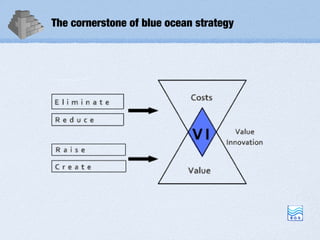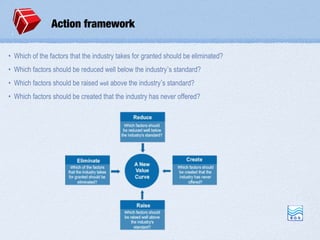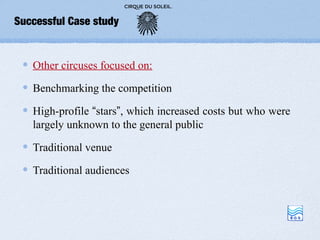Blue Ocean Strategy
- 1. Abdel Salam H. Busalim – MC122009 Abdelrahamn M. Ibrahim – MC112078 Mozhdeh Vahid - MC122055 Mojtaba Zare - 20123M10085 Komeil Raisian Mat - MC 112157 Dr.Ab Razak Che Hussin
- 2. Definitions: Blue Ocean Strategy is a way to make the competition irrelevant by creating a leap in value for both the company and its customers and create new demand in new market space Red oceans mean, all the industries in existence today the known market space. In the red oceans, industry boundaries are defined and accepted, and the competitive rules of the game are known.
- 3. Blue Ocean and Red Ocean Blue Ocean Red Ocean Create uncontested market space. Compete in existing market space Make the competition irrelevant. Beat the competition. Exploit existing demand. Create and capture new demand Align the whole system of a company’s Align the whole system of a company’s activities in pursuit of differentiation and low activities with its strategic cost. Break the value/cost trade-off. Make the value/cost trade-off.
- 4. The cornerstone of blue ocean strategy
- 5. Action framework • Which of the factors that the industry takes for granted should be eliminated? • Which factors should be reduced well below the industry’s standard? • Which factors should be raised well above the industry’s standard? • Which factors should be created that the industry has never offered?
- 6. Principles of formulating BOS Reconstruct Market Boundaries : path One : Look across alternative industries Path Two: Look across strategic groups within industries Path Three: Look across the chin of buyers Path Four : Look across Complementary products and services offering. Path Five : Look across functional or emotional appeal to buyers . Path Six : Look across Time Focus on the big picture not the numbers Reach beyond existing demand Get strategic sequence right Overcome key organizational hurdles Build execution into strategy
- 8. Successful Case study Other circuses focused on: Benchmarking the competition High-profile “stars”, which increased costs but who were largely unknown to the general public Traditional venue Traditional audiences
- 9. Successful Case study • Cirque du Soleil focused on: Creation of a hybrid between the circus and the theatre Retention of the symbolic and glamorous aspects of circus, such as the tent and the more breathtaking aspects, such as acrobats. Incorporation of more comfort, sophistication, elegance and theatrical plots; this brought not only the richness of theatre but a whole new demographic of customers It looked across market boundaries and created new ones.
- 10. Advantages of BOS The current market space gets increasingly crowded, profit and growth prospects shrink, BOS opens prospects for new market space . Create new and capture demands from the new market space. Drive profitable growth. The competition in blue oceans strategy is irrelevant.
- 11. limitations of BOS The value innovation does not make sense to company's conventional logic. Blue ocean strategy may conflict with other company's brand image. Natural monopoly; the market often cannot support a second payer. Network externalities discourage imitation, because imitation often required changes in the existing business practices .












